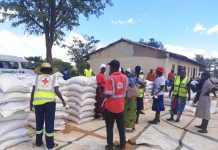Farai Mabeza
The national cattle herd decreased by 4.7 % from 5 774 525 in 2018 to 5 489 364 in 2019, according to the First Round Crop and Livestock Assessment Report for the 2019/2020 season done by the Ministry of Lands, Agriculture, Water and Rural Resettlement.
The decreases in cattle numbers were attributed to deaths due caused by tick-borne diseases and drought.
A total of 66 088 cattle succumbed to drought with Masvingo and Matabeleland South being the worst affected provinces. Diseases contributed 44% to cattle deaths followed by drought 40 %, predators 8%, injury 5% and the remaining 3% were other causes.
“Tick borne diseases continue to pose a serious threat to the national herd. This is a continuation of the problem that started in 2017 when the national dipping programme started to face serious challenges.
“The highest number of cattle deaths have been attributed to Theileriosis with Mashonaland East, West, Central and parts of Manicaland being the worst affected,” the report says.
There is a lot of cattle destocking in areas hit by Theileriosis as desperate farmers sell to middlemen who are taking advantage and buying at very low prices. Other tick borne diseases reported were Anaplasmosis (Gall sickness), Babesiosis (Red water) and Heart water.
During the same period total national milk production increased by 5.89% from 75.4 million litres in 2018 to 79.9 million litres in 2019.
The dairy herd stands at 38 000 of these, 12 000 are in milk producing an average of 14 litres per cow per day.
There was a drop in foot and mouth disease (FMD) outbreaks in 2019 compared to 2018. The disease was reported in only four provinces namely, Mashonaland Central, Masvingo, Matabeleland South and Midlands compared to all provinces in 2018.
A total of 656 500 doses of FMD vaccine were availed against a requirement of 900 000 and 638 441 cattle were vaccinated.
Inadequate anthrax vaccination programmes in 2019 resulted in an increase in cases compared to 2018 with 20 outbreaks compared to 9 the previous year.
The number of goats increased from 3 707 357 in 2018/2019 to 4 360 838 in 2019/2020. Goats’ deaths were due to diseases which accounted for 53% followed by predation at 26%, drought 12%, injury 5% and to other causes 4%.
Pigs declined from 278 297 to 227 749.
The 2019/2020 season was marked by a delayed onset of the season and a false start throughout the country. The Government, private sector and NGOs supported production through a number of input schemes.
The prices of inputs on the open market were out of reach for most of the farmers. Area planted to maize decreased by 5% from 1 623 757 Ha to 1 549 324 Ha.
The communal sector still contributes the largest area under maize (58%), whilst the large scale and A2 contributed 8% of the area under maize a one percent drop from 9% in the 2018/19 season
A total of 106 520ha of maize have been written of due to prolonged dry spells.
Tobacco area decreased by 6% from 106 558 Ha to 100 426 Ha. Cotton area decreased by 13% from 197 242 Ha in 2018/2019 season to 170 622Ha in the 2019/2020 season.
Soyabean area decreased by 40% from 55 660 Ha to 33 599Ha in the 2019/2020 season.
“The decrease is attributed to the late onset of the season, false start coupled with high temperatures, erratic rainfall distribution; prolonged long dry spells during the first half of the season, late distribution of inputs and the high input price on the open market,” the report says.
The targeted area for cotton was not achieved due to the erratic rainfall pattern in the traditional cotton growing areas. Most farmers who could not plant have kept cotton seed for next season.
There was a marked increase in area under sorghum from 201 065 ha to 305 865 ha (52%) across all provinces while pearl millet increased by 10% from 151 708 ha to 166 429ha.
Area under finger millet increased by 37% from 25 146ha in the last season to 34 353ha this season
This may be attributed to deliberate efforts to support traditional grains production through the Presidential input support scheme, donor community and private contractors.
Tobacco area decreased by 6% from 106 558 ha in the last season to the current 100 426 ha. Black shank disease is a serious threat to tobacco output especially in Mashonaland west province.












